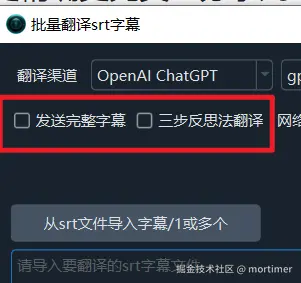AI is becoming more powerful and affordable, making AI subtitle translation faster and cheaper than traditional tools like Baidu Translate or Google Translate! The quality of the translation depends not only on how "smart" the AI model is but also on how well you write the "instructions" (i.e., prompts).
Although video translation software comes with built-in "instructions," you can definitely improve them based on your own experience for better results! This article explains how AI translation works, what to pay attention to when using it, and shares several useful "instructions" for reference.
In video translation software, AI translation prompts can be categorized into three types:

Do Not Send Full Subtitles
Enable by: Unchecking Send Full Subtitles in the software
Only the text lines from the subtitles are sent to the AI for translation; line numbers, timecodes, and blank lines are not included.
Advantages: Saves tokens and reduces API call costs.
Disadvantages: Requires strict correspondence between the number of lines in the translation and the original text. However, due to differences in grammar and word order between languages, the translation may merge lines, resulting in blank lines.
For example, if the original text has 10 lines, the expected translation should also have 10 lines. But the actual result might be 8 or 9 lines because the AI might translate two adjacent original lines into one translated line, leading to blank lines.
Example of 2 original lines:
星期六时, 我们去吃火锅吧.Expected translation should also have 2 lines, but the AI might translate it into one line, as shown below:
Let's go for hot pot on Saturday [This is a blank line]Even if prompts are used to enforce line correspondence, the AI may not strictly follow them.
Send Full Subtitles
Enable by: Checking Send Full Subtitles in the software
The complete subtitle content, including line numbers, timecodes, subtitle text, and blank lines, is sent to the AI for translation.
Advantages: Significantly reduces the likelihood of blank lines.
Disadvantages:
- Cannot completely eliminate the occurrence of blank lines.
- Line numbers and timecodes do not need to be translated but are still sent and returned, wasting tokens and increasing AI costs.
How to Improve Translation Quality:
- Use more advanced and updated models, such as
Deepseek-r1,chatgpt-o3,qwen2.5-max, etc. - Enable
Send Full Subtitles. - If using models with chain-of-thought capabilities, such as
deepseek-r1/o3, reduce the number of subtitle lines sent to prevent output token truncation and errors. Set the number inMenu > Tools/Advanced Options > Advanced Options > AI Translation Lines Sent per Request, as shown below.

Prompt files ending with
-en.txtare used when the software interface is in English. For example,chagpt-en.txt.
